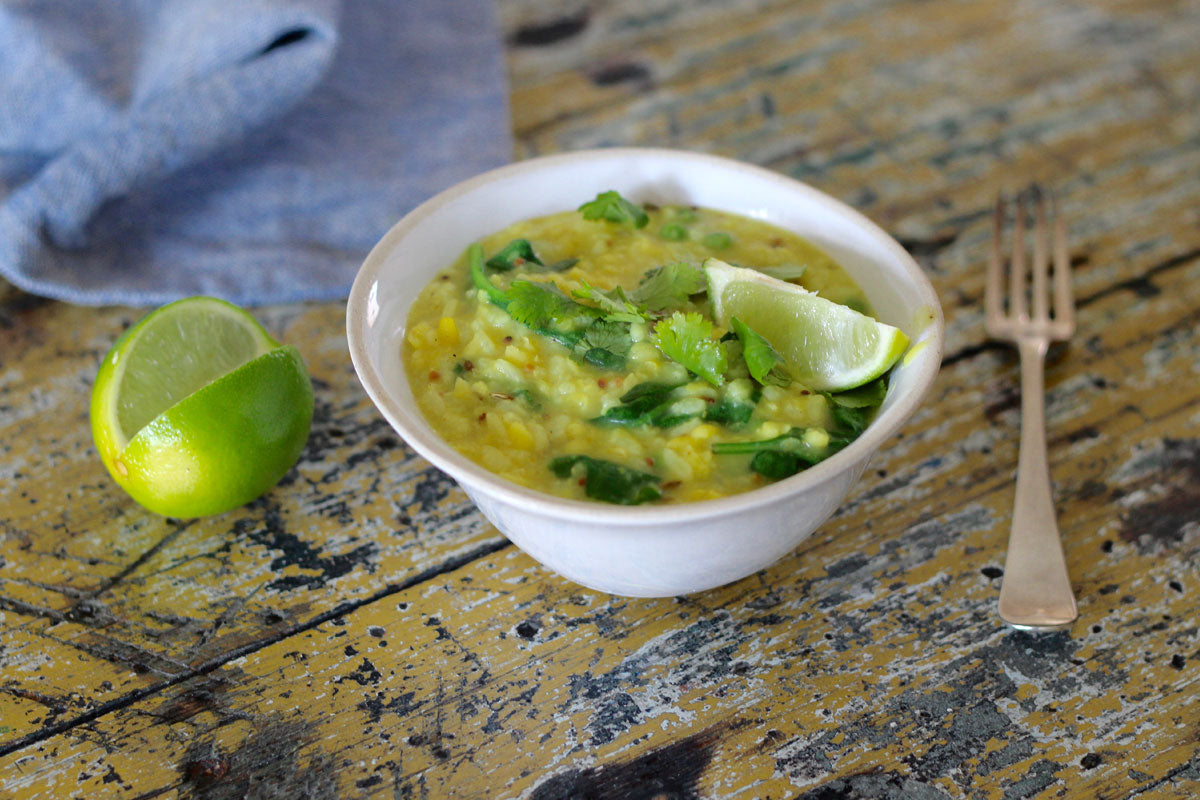Ancient Ayurvedic Cleansing Kitchari

There's a tasty new kid on my dinner table 'block', and it's called Kitchari (pronounced Kitch-r-ree), known by many other similarly spelt names. Kitchari is a meal I became (more than) familiar with whilst undergoing the ayurvedic detox program panchakarma at an ashram in India (there's a little more about that adventure here). Kitchari is an ancient Ayurvedic cleansing meal renowned for it's detoxifying and cleansing properties, and for balancing the doshas. It's also said to aid in weight loss, heal the gut and promote inner calm.
Super simple to make, kitchari describes any meal made with rice and beans, though traditionally kitchari is made with mung daal (also known as moong daal or split yellow mung beans) which, when split with their husks remove become very easy to digest. Significantly they are said to be one of the only legumes not responsible for producing gas #win. Traditionally white rice is used in a cleanse because the body needs easily digestible foods, the husk of brown rice being more difficult to digest. For many thousands of years, rice and beans have been combined to provide a complete protein for cultures living on plant based diets (of which mine appears to have become, but more on that next week).
During a cleanse, people may choose to eat kitchari for each meal of the day (and let it be known, I've been doing that on occasion, more out of convenience than anything else!). Inspiration for the below recipe has come from my lovely friend Jacqui Lewis of The Broad Place, I've simply fiddled around with the flavours for my own personal taste. Feel free to play around with these further, adding more or less spice (it can take a lot of salt). Know though that kitchari is not designed to be super powerful in flavour, it's considered a more gentle dish. It's also not traditionally made with onion or garlic but do add this if you so desire.
Makes approximately 6 bowls
You will need:
6-7 cups cold filtered water
1 cup mung daal (found in an Indian store or online here as organic moong dhal), soaked*
1/2 cup basmati rice, uncooked, soaked*
1/2 cup peas, freshly podded or frozen
1 huge handful baby spinach
1 handful coriander leaves, torn
1 large tablespoon ghee (or coconut oil if you're dairy intolerant)
1 tablespoon mustard seeds
1 tablespoon fennel seeds
1 tablespoon fresh ginger, grated
2 teaspoons fresh turmeric, grated (or 1 teaspoon powder)
1 teaspoon ground cumin
1/2 teaspoon coriander powder
1/2 teaspoon salt, or to taste
Pinch cinnamon
Fresh lemon
Sea salt.
*The night before, place uncooked rice and mung daal in a large bowl and submerge in filtered water. Allow to soak overnight.
Heat the ghee in a heavy based pan over medium heat. Add the fresh ginger and turmeric and gently fry for a minute. Add the cumin, cinnamon, coriander powder, mustard seeds and fennel seeds, stirring over the heat for 30 seconds or until aromatic. Drain the rice and mung daal and add to the pan, stirring through the spices.
Add the water to the pan, bring to the boil and then reduce the heat to a simmer with the lid on for 20 minutes. Stir on occasion to make sure it is not sticking to the bottom.
Stir through the baby spinach, peas and coriander leaves. Cook gently for 2 more minutes over low heat.
Serve in bowls garnished with fresh lemon (and naan and roti on the side if you're feeling fancy!). I like to eat mine for breakfast, often to be followed by lunch.. and yep, on occasion, dinner.



















































